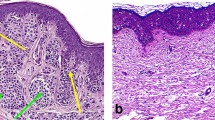Abstract
In cosmetic clinical practice, many patients express the desire for removal of melanocytic nevi, especially those on the face. The carbon dioxide (CO2) laser currently is the preferred for treatment of such lesions because of less scar formation, less bleeding, and simplicity of the procedure. However, if the diameter of the lesion is greater than 5 mm, many clinicians prefer surgical resection to laser resection because laser resection of relatively large nevi often results in the formation of a conspicuous dimple. The authors developed a serial laser excision method for melanocytic nevi larger than 5 mm, with division of the lesion into multiple segments, which allowed the ablated area to gain optimal granulation and reepithelialization, leading to a satisfactory cosmetic appearance. This novel procedure was performed for 25 patients with melanocytic nevi ranging from 5 to 10 mm in diameter. The lesions were divided into two segments in 21 patients, three segments in 3 patients, and four segments in 1 patient. The divided parts of the lesions were ablated by CO2 laser serially at intervals of 2–4 weeks. All the patients obtained optimal granulation and epithelialization in the treated lesions, and the final appearance was satisfactory. Although the therapeutic period was longer than for a surgical excision or a single laser treatment, the new treatment approach of serial excision by CO2 laser achieved favorable outcomes for the treatment of relatively large nevi 5–10 mm in size.
Level of Evidence V
This journal requires that authors assign a level of evidence to each article. For a full description of these Evidence-Based Medicine ratings, please refer to the Table of Contents or the online Instructions to Authors www.springer.com/00266.




Similar content being viewed by others
References
Ashinoff R (1994) Introduction to lasers. Semin Dermatol 13:48–59
Olbricht SM (1993) Use of the carbon dioxide laser in dermatologic surgery: a clinically relevant update for 1993. J Dermatol Surg Oncol 19:364–369
Polder KD, Landau JM, Vergilis-Kalner IJ, Goldberg LH, Friedman PM, Bruce S (2011) Laser eradication of pigmented lesions: a review. Dermatol Surg 37:572–595
Benedict LM, Cohen B (1991) Treatment of Peutz-Jeghers lentigines with the carbon dioxide laser. J Dermatol Surg Oncol 17:954–955
Kirschner RA (1984) Cutaneous plastic surgery with the CO2 laser. Surg Clin North Am 64:871–883
Gottschaller C, Hohenleutner U, Landthaler M (2006) Metastasis of malignant melanoma 2 years after carbon dioxide laser treatment of a pigmented lesion: case report and review of the literature. Acta Derm Venereol 86:44–47
Kopera D (1995) Treatment of lentigo maligna with the carbon dioxide laser. Arch Dermatol 131:735–736
Reynolds N, Kenealy J, Mercer N (2003) Carbon dioxide laser dermabrasion for giant congenital melanocytic nevi. Plast Reconstr Surg 111:2209–2214
Olbricht SM, Stern RS, Tang SV, Noe JM, Arndt KA (1987) Complications of cutaneous laser surgery. Arch Dermatol 123:345–349
Al-Hadithy N, Al-Nakib K, Quaba A (2012) Outcome of 52 patients with congenital melanocytic naevi treated with ultrapulse carbon dioxide and frequency-doubled Q-switched Nd-Yag laser. J Plast Reconstr Aesthet Surg 65:1019–1028
Stern RS, Dover JS, Levin JA, Arndt KA (1994) Laser therapy versus cryotherapy of lentigines: a comparative trial. J Am Acad Dermatol 30:985–987
Dave R, Mahaffey PJ (2004) Combined early treatment of congenital melanocytic naevus with carbon dioxide and NdYag lasers. Br J Plast Surg 57:720–724
August PJ, Ferguson JE, Madan V (2011) A study of the efficacy of carbon dioxide and pigment-specific lasers in the treatment of medium-sized congenital melanocytic naevi. Br J Dermatol 164:1037–1042
Mandal A, Al-Nakib K, Quaba AA (2006) Treatment of small congenital nevocellular naevi using a combination of ultrapulse carbon dioxide laser and Q-switched frequency-doubled Nd-YAG laser. Aesthetic Plast Surg 30:606–610
Bernstein EF (2007) Laser tattoo removal. Semin Plast Surg 21:175–192
Kim SH, Roh SG, Lee NH, Yang KM (2013) Radiofrequency ablation and excision of multiple cutaneous lesions in neurofibromatosis type 1. Arch Plast Surg 40:57–61
Conflict of interest
The authors have no conflicts of interest to disclose.
Author information
Authors and Affiliations
Corresponding author
Rights and permissions
About this article
Cite this article
Ozaki, M., Suga, H., Eto, H. et al. Efficacy of Serial Excisions of Melanocytic Nevi on the Face Using a Carbon Dioxide Laser: A Cosmetic Point of View. Aesth Plast Surg 38, 316–321 (2014). https://doi.org/10.1007/s00266-014-0303-9
Received:
Accepted:
Published:
Issue Date:
DOI: https://doi.org/10.1007/s00266-014-0303-9



